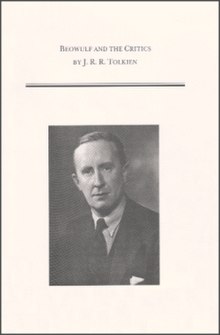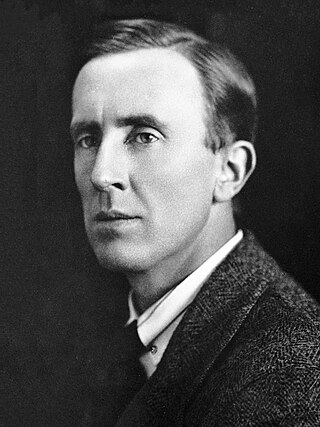
John Ronald Reuel Tolkien was an English writer and philologist. He was the author of the high fantasy works The Hobbit and The Lord of the Rings.

Thomas Alan Shippey is a British medievalist, a retired scholar of Middle and Old English literature as well as of modern fantasy and science fiction. He is considered one of the world's leading academic experts on the works of J. R. R. Tolkien about whom he has written several books and many scholarly papers. His book The Road to Middle-Earth has been called "the single best thing written on Tolkien".

The Monsters and the Critics, and Other Essays is a collection of J. R. R. Tolkien's scholarly linguistic essays edited by his son Christopher and published posthumously in 1983.
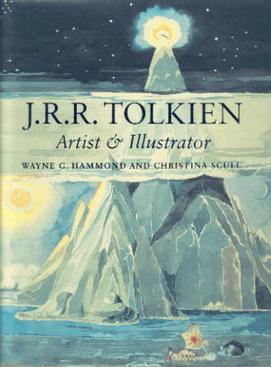
J. R. R. Tolkien: Artist and Illustrator is a collection of paintings and drawings by J. R. R. Tolkien for his stories, published posthumously in 1995. The book was edited by Wayne G. Hammond and Christina Scull. It won the 1996 Mythopoeic Scholarship Award for Inklings Studies. The nature and importance of Tolkien's artwork is discussed.

The Mythopoeic Awards for literature and literary studies are given annually for outstanding works in the fields of myth, fantasy, and the scholarly study of these areas. Established by the Mythopoeic Society in 1971, the Mythopoeic Fantasy Award is given for "fiction in the spirit of the Inklings", and the Scholarship Award for non-fiction work. The award is a statuette of a seated lion, with a plaque on the base. It has drawn resemblance to, and is often called, the "Aslan".
Mythopoeia, or mythopoesis, is a narrative genre in modern literature and film where an artificial or fictionalized mythology is created by the writer of prose, poetry, or other literary forms. This meaning of the word follows its use by J. R. R. Tolkien in the 1930s. The authors in this genre integrate traditional mythological themes and archetypes into fiction. Mythopoeia is also the act of creating a mythology.

The Mythopoeic Society (MythSoc) is a non-profit organization devoted to the study of mythopoeic literature, particularly the works of J. R. R. Tolkien, Charles Williams, and C. S. Lewis, all members of The Inklings, an informal group of writers who met weekly in C. S. Lewis' rooms at Magdalen College, Oxford, from the early 1930s through late 1949.

"Beowulf: The Monsters and the Critics" was a 1936 lecture given by J. R. R. Tolkien on literary criticism on the Old English heroic epic poem Beowulf. It was first published as a paper in the Proceedings of the British Academy, and has since been reprinted in many collections.

Paul Harold Kocher was an American scholar, writer, and professor of English. He wrote extensively on the works of J. R. R. Tolkien as well as on Elizabethan English drama, philosophy, religion, and medicine. His numerous publications include studies of Christopher Marlowe and Francis Bacon. He also authored books on the Franciscan missions of 18th- and 19th-century California.
Douglas Allen Anderson is an American writer and editor on the subjects of fantasy and medieval literature, specializing in textual analysis of the works of J. R. R. Tolkien. He is a winner of the Mythopoeic Award for scholarship.
This is a list of all published works of the English writer and philologist J. R. R. Tolkien. Tolkien's works were published before and after his death.
Verlyn Flieger is an author, editor, and Professor Emerita in the Department of English at the University of Maryland at College Park, where she taught courses in comparative mythology, medieval literature, and the works of J. R. R. Tolkien. She is well known as a Tolkien scholar, especially for her books Splintered Light and A Question of Time. She has won the Mythopoeic Scholarship Award four times for her work on Tolkien's Middle-earth writings.
Michael D. C. Drout is an American Professor of English and Director of the Center for the Study of the Medieval at Wheaton College. He is an author and editor specializing in Anglo-Saxon and medieval literature, science fiction and fantasy, especially the works of J. R. R. Tolkien and Ursula K. Le Guin.

The Road to Middle-Earth: How J. R. R. Tolkien Created a New Mythology is a scholarly study of the Middle-earth works of J. R. R. Tolkien written by Tom Shippey and first published in 1982. The book discusses Tolkien's philology, and then examines in turn the origins of The Hobbit, The Lord of the Rings, The Silmarillion, and his minor works. An appendix discusses Tolkien's many sources. Two further editions extended and updated the work, including a discussion of Peter Jackson's film version of The Lord of the Rings.

The final act of the Anglo-Saxon poem Beowulf includes Beowulf's fight with a dragon, the third monster he encounters in the epic. On his return from Heorot, where he killed Grendel and Grendel's mother, Beowulf becomes king of the Geats and rules wisely for fifty years until a slave awakens and angers a dragon by stealing a jewelled cup from its lair. When the angry dragon mercilessly burns the Geats' homes and lands, Beowulf decides to fight and kill the monster personally. He and his thanes climb to the dragon's lair where, upon seeing the beast, the thanes flee in terror, leaving only Wiglaf to battle at Beowulf's side. When the dragon wounds Beowulf fatally, Wiglaf attacks it with his sword, and Beowulf kills it with his dagger.

Beowulf: A Translation and Commentary is a prose translation of the early medieval epic poem Beowulf from Old English to modern English. Translated by J. R. R. Tolkien from 1920 to 1926, it was edited by Tolkien's son Christopher and published posthumously in May 2014 by HarperCollins.
Tolkien's monsters are the evil beings, such as Orcs, Trolls, and giant spiders, who oppose and sometimes fight the protagonists in J. R. R. Tolkien's Middle-earth legendarium. Tolkien was an expert on Old English, especially Beowulf, and several of his monsters share aspects of the Beowulf monsters; his Trolls have been likened to Grendel, the Orcs' name harks back to the poem's orcneas, and the dragon Smaug has multiple attributes of the Beowulf dragon. The European medieval tradition of monsters makes them either humanoid but distorted, or like wild beasts, but very large and malevolent; Tolkien follows both traditions, with monsters like Orcs of the first kind and Wargs of the second. Some scholars add Tolkien's immensely powerful Dark Lords Morgoth and Sauron to the list, as monstrous enemies in spirit as well as in body. Scholars have noted that the monsters' evil nature reflects Tolkien's Roman Catholicism, a religion which has a clear conception of good and evil.
J. R. R. Tolkien, a fantasy author and professional philologist, drew on the Old English poem Beowulf for multiple aspects of his Middle-earth legendarium, alongside other influences. He used elements such as names, monsters, and the structure of society in a heroic age. He emulated its style, creating an impression of depth and adopting an elegiac tone. Tolkien admired the way that Beowulf, written by a Christian looking back at a pagan past, just as he was, embodied a "large symbolism" without ever becoming allegorical. He worked to echo the symbolism of life's road and individual heroism in The Lord of the Rings.
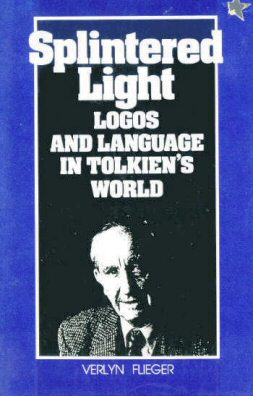
Splintered Light: Logos and Language in Tolkien's World is an 1983 book of literary criticism by the leading Tolkien scholar Verlyn Flieger, in which she argues that light is a central theme of Tolkien's Middle-earth mythology, in particular in The Silmarillion. It has been admired by other scholars to the extent that it has become a core element of Tolkien scholarship.
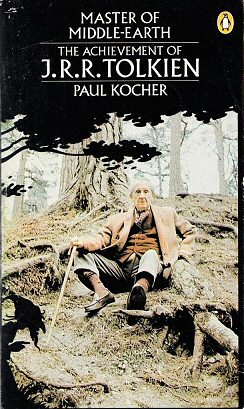
Master of Middle-earth: The Fiction of J. R. R. Tolkien, alternatively subtitled The Achievement of J.R.R. Tolkien, is a 1972 book of literary criticism of J. R. R. Tolkien's Middle-earth fantasy writings, written by Paul H. Kocher, and one of the few to be published in Tolkien's lifetime. It focuses especially on The Lord of the Rings and The Hobbit, and also covers some of his minor works such as "Leaf by Niggle" and "Smith of Wootton Major".
